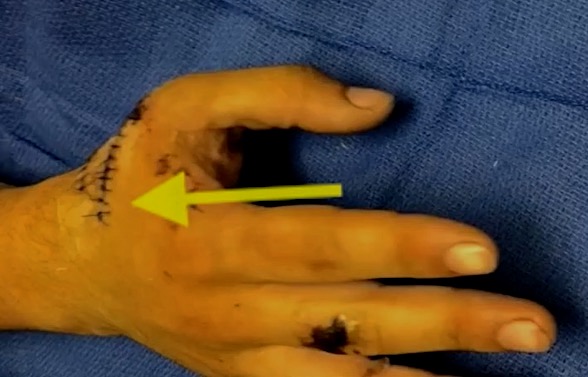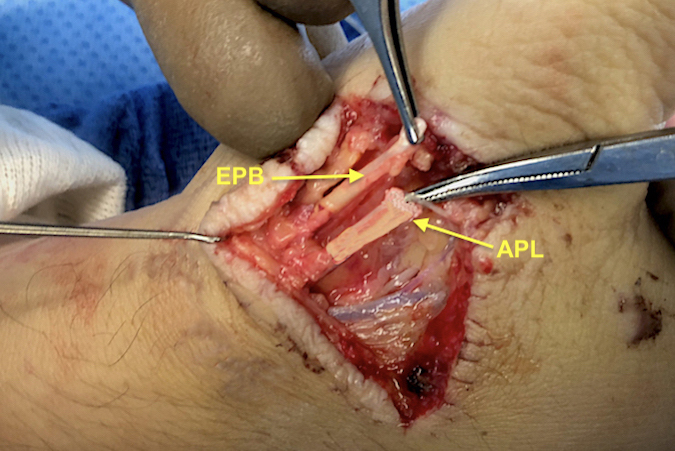Extensor Pollicis Longus (EPL) Exam
EPL Muscle Data:
Origin: Ulna (posterolateral surface of middle shaft) Interosseous membrane
Insertion: Thumb (base of distal phalanx, dorsal side)
Innervation: Cervical roots): C7 and C8
Nerve: radial nerve (posterior interosseous branch)
EPL Muscle Testing:
When examining the dorsal thumb for signs of an acute traumatic EPL laceration, the goal is to determine if the EPL tendon is completely lacerated, partially transected or intact. When examining the function of an uninjured EPL musculotendinous unit for a chronic condition like cerebral palsy, the 0 to 5 muscle testing grading system is used. In this system zero is a complete loss of extensor pollicis longus (EPL) contraction and IP motion and a grade of 5 is normal EPL function that can contract against normal resistance. A complete description of graded muscle testing is available below. Usually, a complete muscle testing cannot be performed in the face of any acute laceration secondary to pain and tenderness. The examiner may have to rely on the observation that the laceration occurred in the dorsal section containing the EPL. However, the examiner should test the contraction of the potentially injured musculotendinous unit as thoroughly as possible. The exam goal is to determine preoperatively if the tendon is cut, partially cut, or intact. If the exam suggests a cut or significantly partially cut tendon, then surgery is indicated.
To examine the position of patient's hand and upper extremity with the forearm in mid-rotation, wrist in neutral with ulnar side of hand resting on the table. Thumb in a flexion or resting posture. Some suggest that for Grades 0-2, the patient places his/her forearm in pronation with wrist in neutral and thumb in relaxed position to start.
The examiner then uses the table to support the ulnar side of the patient's hand and the examiner’s hand to stabilize the proximal phalanx of the thumb. Next the examiner applies pressure with his hand to the dorsal surface of the distal phalanx of the thumb to gently resist the patient’s attempt to actively extend the thumb IP joint. The examiner then instructs the patient to "straighten the end of your thumb tip and hold it. Don't let me push your thumb down." Again, the resistance to extension will vary according to the discomfort created by the examination.
Definition of Positive Result in EPL Muscle Testing: A normal result is a positive one. During a normal muscle test, the examiner should observe a normal muscle contraction that can move the IP joint against resistance.
Definition of Negative Result EPL Muscle Testing: Note the EPL tendon visible and palpable. In muscle testing, an abnormal result is a negative one. During a partially abnormal muscle test, the examiner should observe an abnormal muscle contraction that cannot move the joint or only move it against minimal resistance. In a complete denervation injury, such as a complete radial nerve palsy, there will be no evidence of any muscle contraction, and the muscle testing grade will be zero.
In a patient with a laceration of the EPL proximal to the thumb IP joint, the joint may not actively extend at all secondary to the transection (cut) of the EPL tendon. This will result in an abnormal or negative muscle testing or possibly a grade 3 because of muscle belly contraction without active thumb IP joint extension. These observations will also indicate a complete EPL laceration which needs surgical repair. Therefore, this negative muscle testing exam will be positive for an EPL complete laceration.
- When testing the EPL muscle, the muscle must be palpated proximally for contraction in addition to assessing the thumb IP joint's active extension.
- When testing the EPL tendon, the tendon must also be palpated proximally in addition to assessing the thumb IP joint's active extension.
- Remember the IP joint can be actively extended by the thumb intrinsic (thenar) muscles when the EPL is completely lacerated.
- A quick way to assess the functional status of the EPL is to flick the distal phalanx into flexion. If the finger rebounds or snaps back, this suggests an intact EPL tendon.

